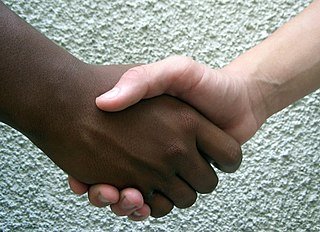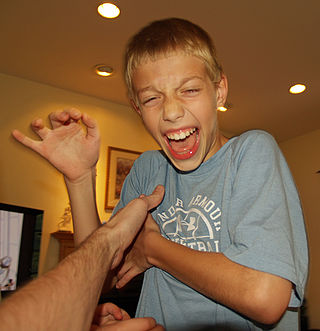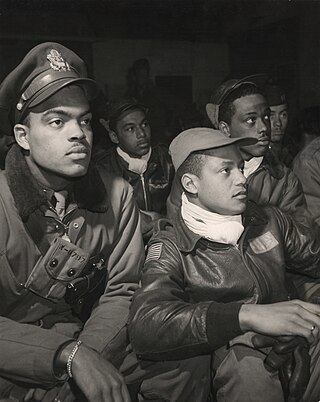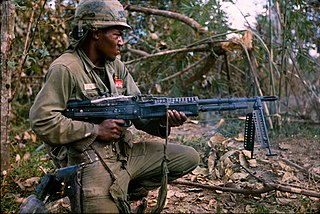
A handshake is a globally widespread, brief greeting or parting tradition in which two people grasp one of each other's hands and in most cases accompanied by a brief up-and-down movement of the grasped hands. Customs surrounding handshakes are specific to cultures. Different cultures may be more or less likely to shake hands, or there may be different customs about how or when to shake hands.

United States Colored Troops (USCT) were Union Army regiments during the American Civil War that primarily comprised African Americans, with soldiers from other ethnic groups also serving in USCT units. Established in response to a demand for more units from Union Army commanders, by the end of the war in 1865 USCT regiments, which numbered 175 in total, constituted about one-tenth of the manpower of the army. Approximately 20 percent of USCT soldiers were killed in action or died of disease and other causes, a rate about 35 percent higher than that of white Union troops. Numerous USCT soldiers fought with distinction, with 16 receiving the Medal of Honor. The USCT regiments were precursors to the Buffalo Soldier units which fought in the American Indian Wars.

Greeting is an act of communication in which human beings intentionally make their presence known to each other, to show attention to, and to suggest a type of relationship or social status between individuals or groups of people coming in contact with each other. Greetings are sometimes used just prior to a conversation or to greet in passing, such as on a sidewalk or trail. While greeting customs are highly culture- and situation-specific and may change within a culture depending on social status and relationship, they exist in all known human cultures. Greetings can be expressed both audibly and physically, and often involve a combination of the two. This topic excludes military and ceremonial salutes but includes rituals other than gestures. A greeting, or salutation, can also be expressed in written communications, such as letters and emails.

Haptic communication is a branch of nonverbal communication that refers to the ways in which people and animals communicate and interact via the sense of touch. Touch is the most sophisticated and intimate of the five senses. Touch or haptics, from the ancient Greek word haptikos is extremely important for communication; it is vital for survival.

The raised fist, or the clenched fist, is a long-standing image of mixed meaning, often a symbol of solidarity, especially with a political movement. It is a common symbol representing a wide range of political ideologies, most notably socialism, communism, anarchism, and trade unionism, and can also be used as a salute expressing unity, strength, or resistance.

Opposition to United States involvement in the Vietnam War began with demonstrations in 1965 against the escalating role of the United States in the Vietnam War and grew into a broad social movement over the ensuing several years. This movement informed and helped shape the vigorous and polarizing debate, primarily in the United States, during the second half of the 1960s and early 1970s on how to end the Vietnam War.

William Henry Johnson, commonly known as Henry Johnson, was a United States Army soldier who performed heroically in the first African American unit of the United States Army to engage in combat in World War I. On watch in the Argonne Forest on May 14, 1918, he fought off a German raid in hand-to-hand combat, killing multiple German soldiers and rescuing a fellow soldier while suffering 21 wounds, in an action that was brought to the nation's attention by coverage in the New York World and The Saturday Evening Post later that year. On June 2, 2015, he was posthumously awarded the Medal of Honor by President Barack Obama in a ceremony at the White House.

A fist bump is a gesture similar in meaning to a handshake or high five. A fist bump can also be a symbol of giving respect or approval, as well as companionship between two people. It can be followed by various other hand and body gestures and may be part of a dap greeting. It is commonly used in sports as a form of celebration with teammates and with opposition players at the beginning or end of a game. Fist bumps are often given as a form of friendly congratulation.

A secret handshake is a distinct form of handshake or greeting which indicates membership in or loyalty to a club, clique or subculture. The typical secret handshake involves placing one's fingers or thumbs in a particular position, one that will be recognized by fellow members while seeming to be a normal handshake to non-members. This is most frequently associated in the popular consciousness with college fraternities, fraternal orders and secret societies.

The pound hug is a stylized greeting, exclusively performed between two people, that consists of a combination of a handshake and one-armed hug. Unlike the traditional hug, which symbolically and effectively removes interpersonal barriers and unites the two persons embracing, the pound hug—performed by keeping the right hand locked in handshake while the left arm wraps around the other's shoulder—interposes the obstacle of the two right arms to the joining of the two bodies.

The military history of African Americans spans from the arrival of the first enslaved Africans during the colonial history of the United States to the present day. African Americans have participated in every war fought by or within the United States, including the Revolutionary War, the War of 1812, the Mexican–American War, the Civil War, the Spanish–American War, World War I, World War II, the Korean War, the Vietnam War, the Gulf War, the War in Afghanistan, and the Iraq War.

Sir! No Sir! is a 2005 documentary by Displaced Films about the anti-war movement within the ranks of the United States Armed Forces during the Vietnam War. The film was produced, directed, and written by David Zeiger. The film had a theatrical run in 80 cities throughout the U.S. and Canada in 2006, and was broadcast worldwide on Sundance Channel, Discovery Channel, BBC, ARTE France, ABC Australia, SBC Spain, ZDF Germany, YLE Finland, RT, and several others.
Long Binh Jail was a U.S. military stockade located at Long Binh Post, in Đồng Nai Province, South Vietnam during the Vietnam War. 90% of the prisoners in the jail were African Americans. The handshake known as the "dap" was created here.

Leo J. Meyer was a soldier in the United States Army, one of only three hundred and twenty-four men who have been awarded three Combat Infantryman Badges out of more than the twenty-three million men who served in the US Army between December 1941 and December 2007. Colonel Meyer was inducted into the U.S. Army Officer Candidate School Hall of Fame in 2009.

The USS Kitty Hawk riot was a racial conflict between white and black sailors aboard the United States Navy aircraft carrier Kitty Hawk on the night of 12–13 October 1972, while positioned at Yankee Station off the coast of North Vietnam during the Vietnam War.
There have been several mutinies by African-Americans in the United States Armed Forces, often owing to racial tension.

African Americans played a prominent role in the Vietnam War. The Vietnam War was the first American war in which Black and White troops were not formally segregated, and even saw significant growth in the number of African Americans engaged in battlefield combat, though some de facto segregation still occurred.

James Thomas Wiley was a U.S. Army Air Forces/U.S. Air Force officer and combat fighter pilot of the 332nd Fighter Group's 99th Pursuit Squadron, best known as the Tuskegee Airmen or "Red Tails".

















